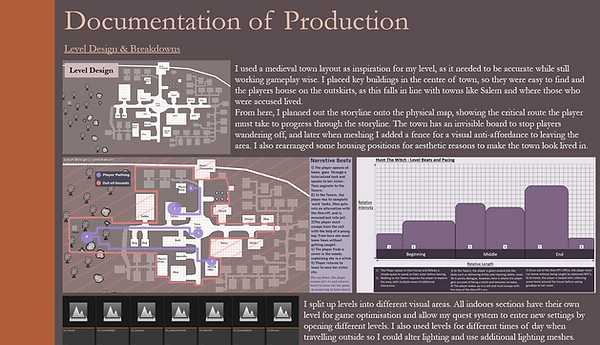Level Design : Single-Player
DESCRIPTION
Here are examples of Single-Player levels I have designed.
YEAR
2024-2025
Floor-54

I designed and implemented a number of levels for a roguelike game, themed around escaping a laboratory using locked doors and keycards.
I made sure to keep this in mind when designing by ensuring the goal of each level was to find the right key card to get out, and the adventure for players was navigating through levels to get to this. Enemy placement was really important in this game, as upon death, the player would restart the whole game with no save points, as a roguelike is designed.
It was imperative that enemies were often enough to ensure a constant sense of tension and pressure was on the player, however, it couldn't be too difficult to cause frustration after multiple attempts, as a game that is simply too hard would put off our audience.
Level Annotations
Experience
I found this project quite difficult, as I was the only senior and person of most experience in a large group of people expected to create a vertical slice of a game. From the start, I took control and started grouping people in the main disciplines of Design, 3D Art, Concept Art, Blueprint Tech and C++ Tech. This allowed me to see how our group was split and what area was our strongest, which seemed to be Art and Tech. Designers only had 3/25, including myself, so I took on head designer as well as project lead to ensure the design team was able to lead the group's ideas effectively.
As a Project Lead, I assigned tasks to team members and kept up to date with what each group was doing. I assigned 'lead' roles to the person with the most experience and confidence in each discipline, whom I was able to meet with to check on progress and discuss game direction, allowing them to go back to their group with tasks and a deadline to split among themselves.
As Lead Designer, I ensured the vision of the game matched the skill and timeframe we as a group had. I made sure our ideas her cohesive across all work, and the team's ideas and tasks came from design as the main output of direction. This made sure that all work given out was what we needed for the game, and would make sense in the bigger picture.
As a Designer, I worked on a range of designs outside my leadership roles. I made several level designs myself as well as reviewing, correcting and giving feedback on other fellow designers' work. I also implemented and built all the levels in the game, setting up the blueprints as well as using pre-made assets to dress interiors. I acted as a play-tester for the game, consistently playing builds and communicating bugs and feedback to the Tech Leads. I designed a number of mechanics for the game, based on group discussions, and generally acted as the person in the group whose ideas were run through before executing and picking up any work that was left over/in need of help.
While this project put a heavy load on me as a leader and designer, I rose to the occasion and performed exceptionally. I learned a great deal about managing others and balancing work tasks, as well as single-player level design and roguelikes in particular. Despite a number of hiccups, the game was delivered on time, to a high standard, and the team were very happy with the work produced - as was I.
Hunt The Witch

For my final year project, I wrote a game narrative that didn't rely on stereotypes, while also educating the player on real-world issues. My main focus was the 17th Witch Trials, where women were targeted by religious fear-mongering and executed wrongfully.
My story follows a young girl who cares for her younger sister and depressed father after their mother was falsely accused and executed recently. The game shows a 'day in the life' for the main character, making the player go through struggles with her until she is accused of witchcraft and must escape her captors.
The level design follows the narrative closely, taking the player to different levels using the illusion of entering buildings and speaking to NPCs.
Level Design Annotations


Adventure/Puzzle RPG
Deek's Castle Run

Deek's Castle Run was a short puzzle-RPG where the player tried to escape a castle as a small goblin called Deek. The start begginin the dungeons, and the game works up to the throne room where the King Goblin and final boss reside.
The game features a range of puzzles, from timed parkour across moving platforms to sectre doors and button sequences. I specifically designed with these mechanics in mind, and created additional areas only accessible if the player ultilised mechanics taught to them before hand.
The game was short but fun to play, and gave me a taste of puzzle design and how to make tasks difficult enough to pause the player but not allow them to get stuck.
Systems Creation

As part of my exploration of Unreal Engine game systems, I created a game from scratch with basic mechanics.
To showcase this, I built a series of levels to show off each area of mechanics and demonstrate how they would work. The levels were inspired by floating islands and were the base of a game that revolved around parkour in the sky.






